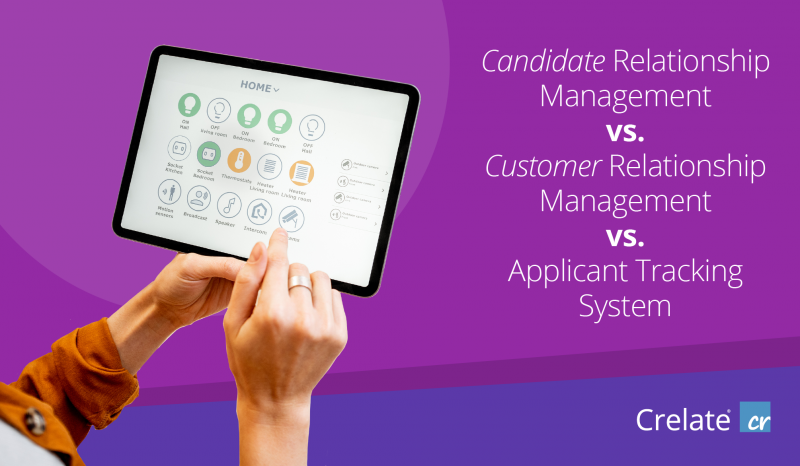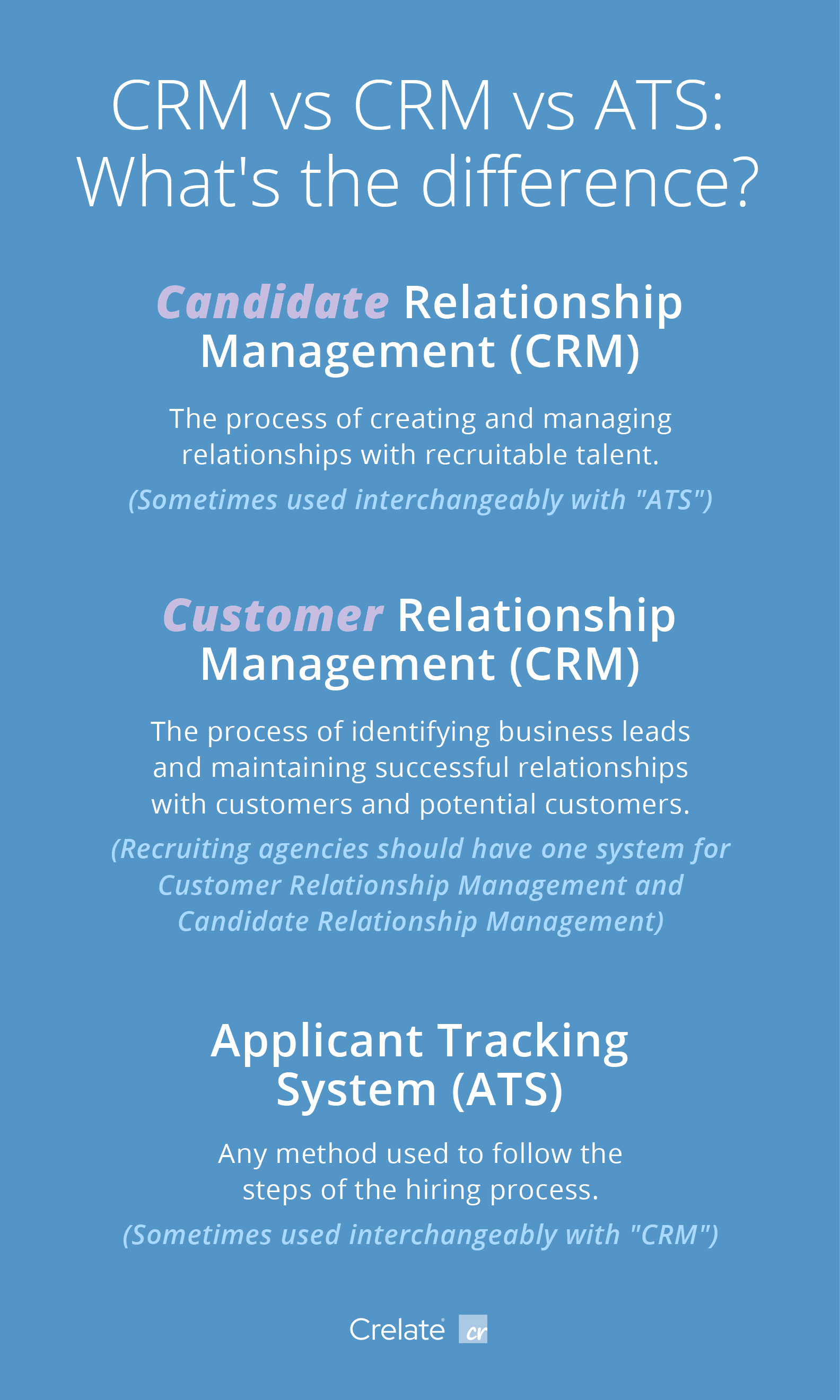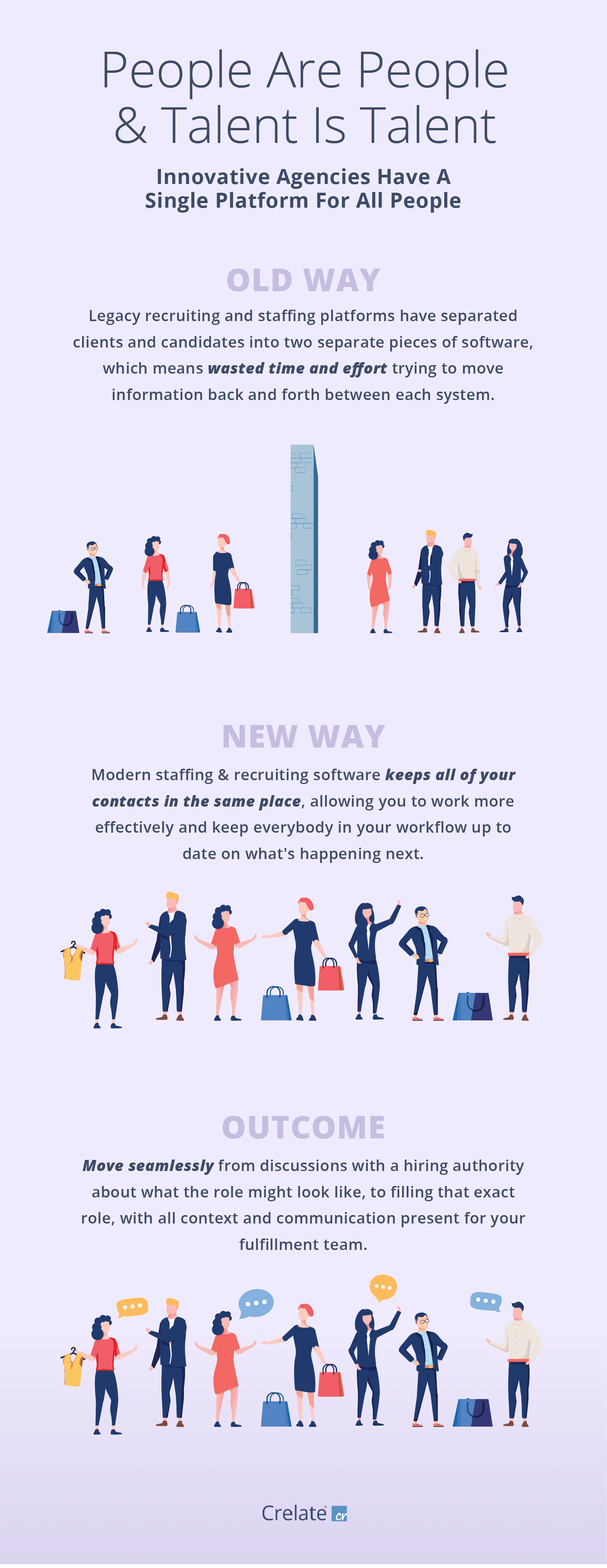
The recruiting industry suffers from a bit of an acronym problem. There’s the term “CRM,” which means one thing to recruiters, and something else to the rest of the business world. Then there’s “ATS”, which some recruiters use interchangeably with CRM (though not the CRM).
Confused yet? We’re here to clear this up – and explain why the best solution is to free yourself of acronym creep and commit to one, flexible talent management system to power your agency.

What Does CRM Stand For In Recruiting?
CRM can stand for either Candidate Relationship Management or Customer Relationship Management. At Crelate, we believe it’s important for agencies to combine the two processes.
What Is The Difference Between an ATS and CRM?
An ATS or Applicant Tracking System describes any process organizations use to keep track of job applicants – from an Excel spreadsheet to an advanced software system. CRM or Candidate Relationship Management typically refers to a broader process that includes candidate experience management, communication tools, some automation, and reporting around the effectiveness of communication at keeping talent engaged.. Still, the terms are sometimes used interchangeably.
Candidate Relationship Management (CRM)
Candidate Relationship Management is the process of creating and managing relationships with recruitable talent. Using recruitment CRM software can keep your candidates engaged and help your teams better manage their talent pools.
A robust CRM platform is technology that makes this process more efficient. See: What You Should Look For in a Recruiting CRM
Recruiters use Candidate Relationship Management tools to store information about talent, automate contacts and processes where needed, and track overall trends and performance of their recruiting efforts.
Among the common features of a Recruiting CRM are:
- Advanced analytics
- Collaboration tools for recruiting teams
- Automated communication with candidates and clients
Customer Relationship Management (CRM)
Customer Relationship Management is the process of identifying business leads and maintaining successful relationships with customers and potential customers.
While that might seem obvious to anyone who’s been in business over the last 15 years, it’s important to remind ourselves from time to time that the tool is here to facilitate that process. The tool itself is not the process.
Many traditional CRM platforms exist to make this process more efficient and automated. The best-known CRM is Salesforce, which is a generic platform that you can customize for your business. However, CRMs also exist for specific industries, including the recruiting industry.
Some recruiting agencies have two separate platforms: A Candidate Relationship Management platform that their recruiting teams use to interact with talent, and a Customer Relationship Management platform that their salespeople use to monitor leads and develop opportunities. At Crelate, we strongly advocate for combining these two activity streams into one platform. Below we’ll discuss some of the practical benefits to agencies of that approach.
Among the common features of Customer Relationship Management are:
- Sales team collaboration tools
- Marketing automation
- Customizable analytics
Applicant Tracking System (ATS)
An ATS (Applicant Tracking System) provides visibility into the hiring process from initial contact, to intake of a candidate, to the acceptance of a job offer.
Many large organizations who are generally under great pressure to maintain recruiting process compliance rely on their ATS for this piece of the puzzle. As a core system, the ATS needs to provide a clear trail and record of every candidate interaction from application to offer acceptance or rejection letter.
Anyone involved in hiring – from an experienced agency recruiter to an administrative assistant at a small business – will use some form of ATS to track the hiring process.
For recruiters, applicant tracking is just one facet of the job. Effective recruiters and HR professionals do more than “track” job applicants as they move through a linear process. Today’s talent management is about relationships, experience, and engagement – a cyclical process without a defined beginning or end point.
Among the common features of an Applicant Tracking System are:
- Powering the online application or CV submission process
- Storage of candidate contact information
- Compliance with legal/corporate requirements for communication and disclosures
- Ability to share information within teams (or prevent sharing).
The Old Way: Tracking and Compliance Over Relationships
The term Applicant Tracking System is still useful, but it comes with baggage or connotation of an older way of recruiting. People would apply, you’d track them through the process. Rinse, and repeat. Today’s successful recruiters do more – focusing on applicant experience and talent engagement.
Many ATSs will feed into HR software suites and vice versa. Many of these monster HCM (Human Capital Management) platforms originated to maximize compliance. The HR departments of big companies generally bought them to help ensure compliance with legal requirements, rather than enable recruiters to build meaningful relationships with talent. When you hear the words speed and flexibility, HR and compliance might not be the first department that comes to mind.
As an agency, when you’re in the early stages of working with a hiring authority, everything’s fluid and every variable is constantly changing. The salary might be in flight, where even the job itself might be subject to change. The candidates you have at the ready, and what the hiring manager both needs and wants can change from day to day.
Everything’s moving, and a system that’s built purely for tracking and compliance won’t get the job done.
The Limitations of One Software Force Your Business To Add Another
I’ve heard of big, successful companies – companies who should know better – that have as many as 5 or 6 different systems for the people, the talent, that they deal with. They’ll have one system for current employees, one system for potential employees, yet another system for alumni employees. Then a system for current clients, and another for potential clients and one more for marketing functions.
Every agency owner needs two things to run their business beyond the obvious basics like the phone system and a very sturdy coffee maker. You need some sort of Customer Relationship Management (CRM) tool. That’s where you track the money that’s coming in, what you’re selling and how you’re supporting those customers.
And you need you some sort of system to track people – people you have hired, people you might hire. You might call that an Applicant Tracking System, but you’re likely to use it for far more than that.
Meanwhile, some of the newer recruiting or TA software products – while they are much more flexible and user-friendly than the ATSs of the past – aren’t attuned to the needs of a recruiting or staffing agency. In some of these systems, revenue or “deals” simply don’t exist as a concept. The systems are 100% about the applicant/talent side of the business and 0% about the fact that recruiting agencies need to make money, too.
Obviously, for any recruiting agency, revenue is paramount. But also, you’re placing across a diverse set of customers, from HR managers to corporate boards. Not to mention the fact that a relationship you’ve developed with an A-player can shift from candidate to hiring manager, and back again. Sometimes multiple times throughout a career.

When you think about the operations of different businesses, the term “customers” can mean very different things. If you’re Google or Facebook for instance, you have a set of customers that buy ads on your platform, and a huge pool of humans using your service that are also your customers.
In the recruiting world, the client and the candidate are both your customer. You are a people-driven business in every sense. On one hand, you need to keep your client up to speed as your search progresses. And on the other, your job is not just to identify and evaluate talent, but to nurture that relationship, build excitement about a new role, and ensure they’re excited enough to see the entire process of changing jobs through to the end. Sometimes even helping that A-player find multiple roles over the course of a career if they trust and value your approach.
What’s more, for recruiters, a candidate can quickly and literally become a client. This can get cumbersome to say the least if your CRM software doesn’t understand a person as a person, allowing you to see your entire relationship history with a contact in a single place, without a lot of copy and pasting.
But as obvious as this may seem, many recruiting agencies end up with two (or even three) different systems – one for fulfillment, one for clients.
A CRM and a CRM and an ATS.
Crelate’s Take: A Single System Built For Flexibility And Speed
When you have multiple systems for anything, be it people, process, or both, it will slow you down and cause communication problems.
If you’re a company whose primary business is talent, you want it all in one. You’ve got candidates to source, A-players to nurture, and contracts to win.
The Result: Sales and Recruiting Working Together
In a recruiting agency you have a funnel of deals, and a funnel of talent. And it’s critical that you get those two funnels to align. Allowing your recruiters and your sales team to collaborate by default will evolve them from two separate teams into one: A delivery team.
Let’s consider an example.
A salesperson comes to you saying that they have an opportunity to place 10 Angular developers at a top tech firm. That’s worth $100,000 or even $200,000+ to your agency depending on the negotiation – but your salesperson says it’s only 20% likely.
Still, the likelihood drops to nothing if your recruiting or fulfillment team doesn’t start getting some names or CVs ready to help the salesperson win the deal.
So what’s the req for your fulfillment team? A one-off email from your new business person summarizing a dozen client calls and emails? A hallway conversation? Or should it be the same opportunity, linked to a complete and nuanced communication thread, with the ability to track any candidate submissions side by side with sales meetings, emails, and phone calls?
And whether you’re a full-desk solopreneur, or managing a giant team of agency recruiters, there’s immense value in keeping track of any candidates you’ve submitted on spec as part of that new business process. From client feedback on the candidates to proof that you’ve even submitted them for the role, the people you put forward and the client reaction is critical to both ongoing sales and recruiting success.
With a single system that understands both your sales and recruiting process as one, at any point in time you can open an opportunity up to the recruiting team to start their work in parallel without missing a beat.
Both workflows can now simultaneously move forward, with recruitment activity attached to the same opportunity or req that your sales team will eventually close.
If your systems are separate, you’re forced into a waterfall workflow that isn’t as nimble, and will cost you time and money.
To Err (in a CRM) is Human – To Adapt Quickly is Divine
And in all this you know that sometimes your team will work too fast and forget to enter some critical piece of information. That you’ll realize there was a nuanced detail about why a candidate was (or wasn’t) perfectly qualified for an open role. That in slow times, you’ll have a chance to do some of the data entry around a candidate or search that you simply couldn’t afford to do when you were juggling 30 reqs.
Many ATS products that were built with a compliance-first mindset miss that idea by a mile.
This is why we emphasize flexibility as a natural part of the recruiting process. We let you skip steps, we let you make mistakes, we let you go back. We let you fill in the fields you have when you have them and change them later. We’re not about enforcing a rigid HR process.
If you can develop a process, complemented by tools, that both allows you to move fast and flexibly, while still being a backstop and a command center, that’s your business.
So, What’s the Verdict for Your Agency: CRM, CRM, or ATS?
We hope by now it’s clear that you shouldn’t have to choose. And that the right system will allow for the best and most important parts of each process to come together intuitively to power your business.
To learn more about how Crelate can help you be more efficient and win more business, schedule a demo today.

